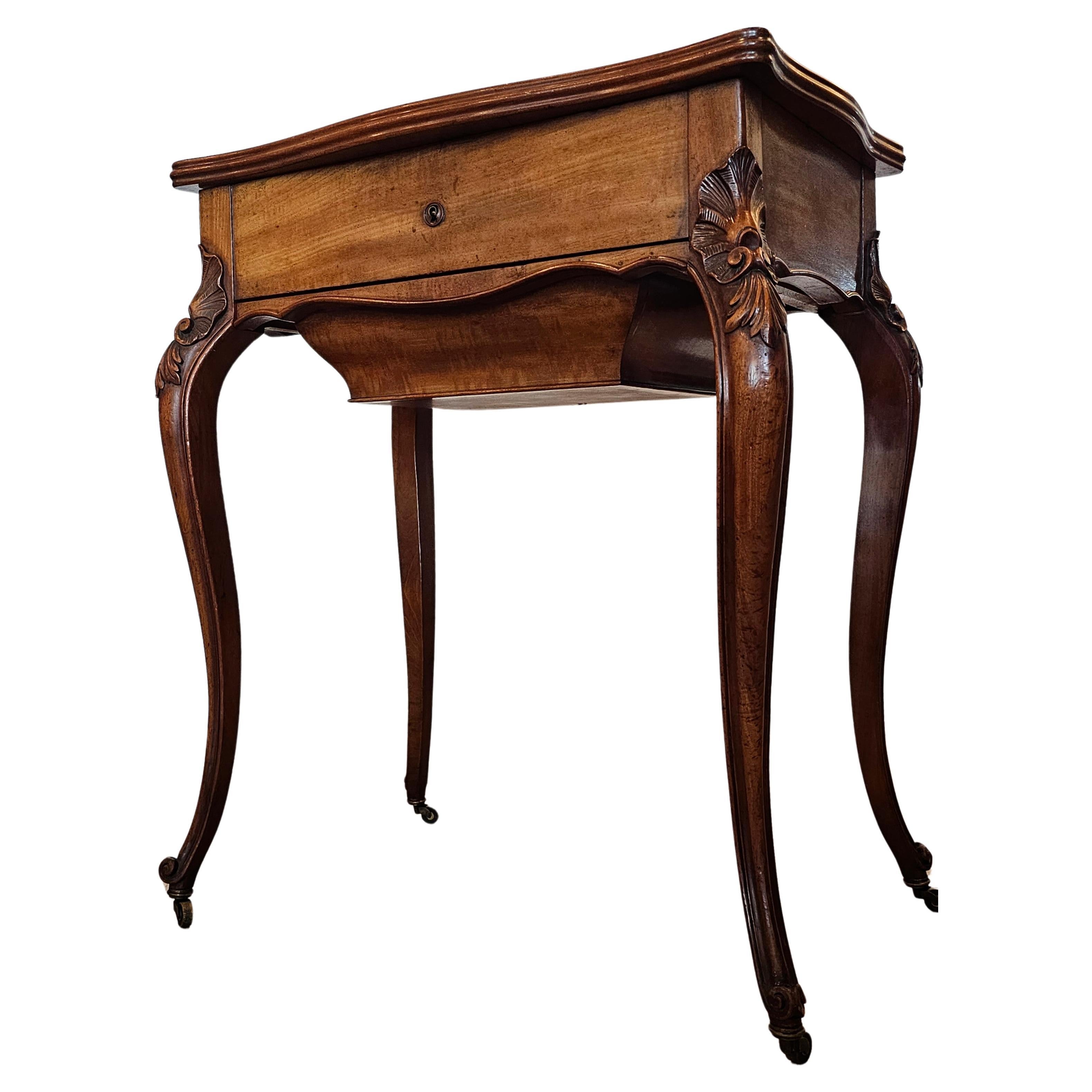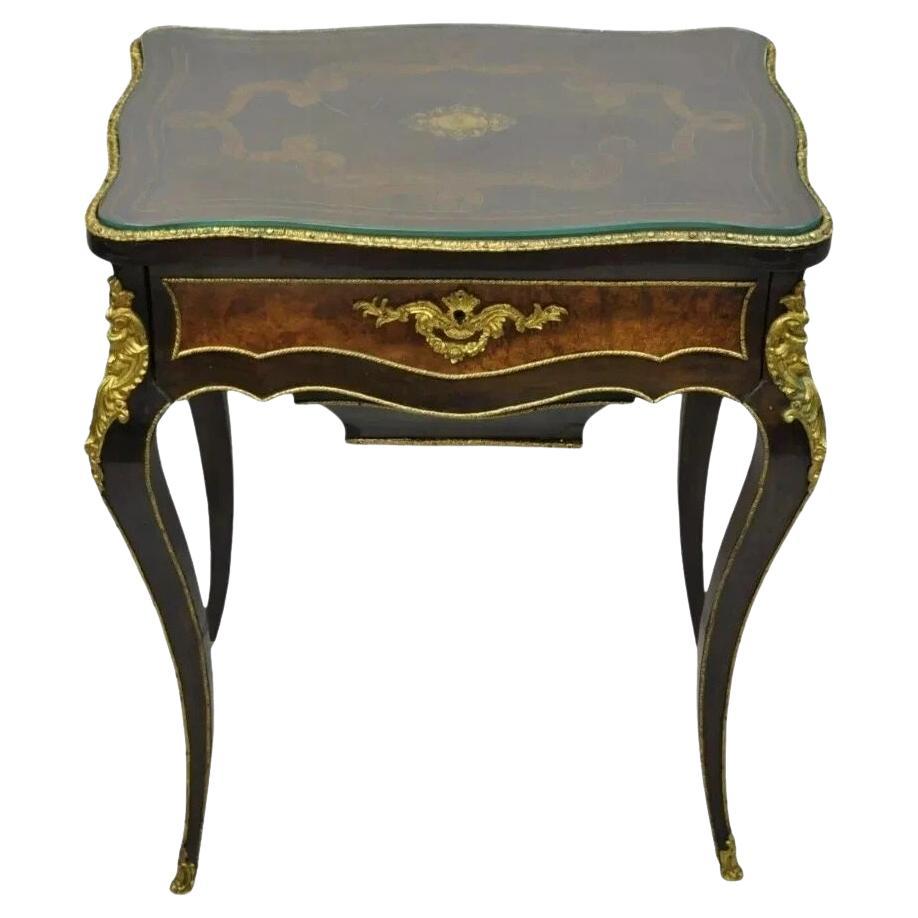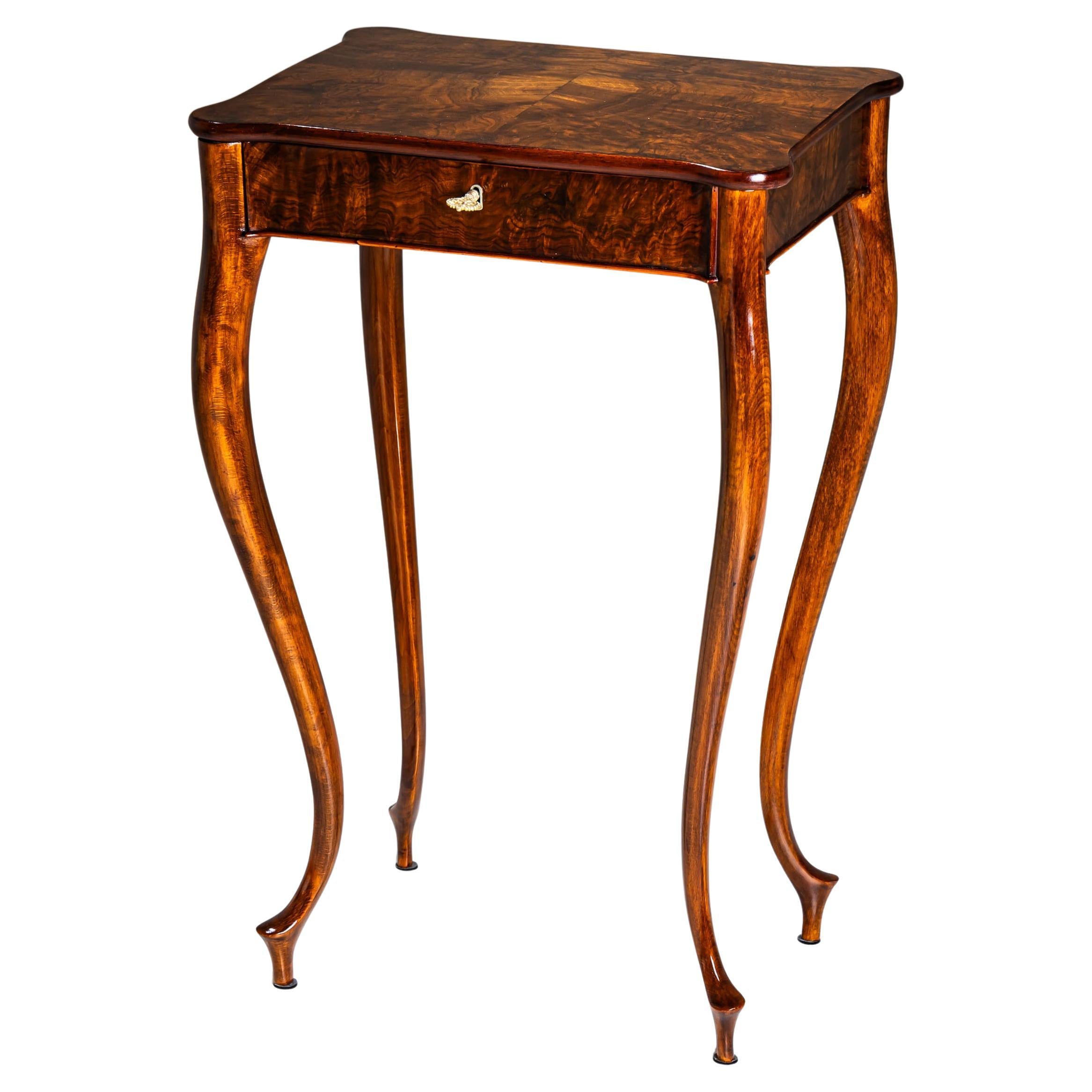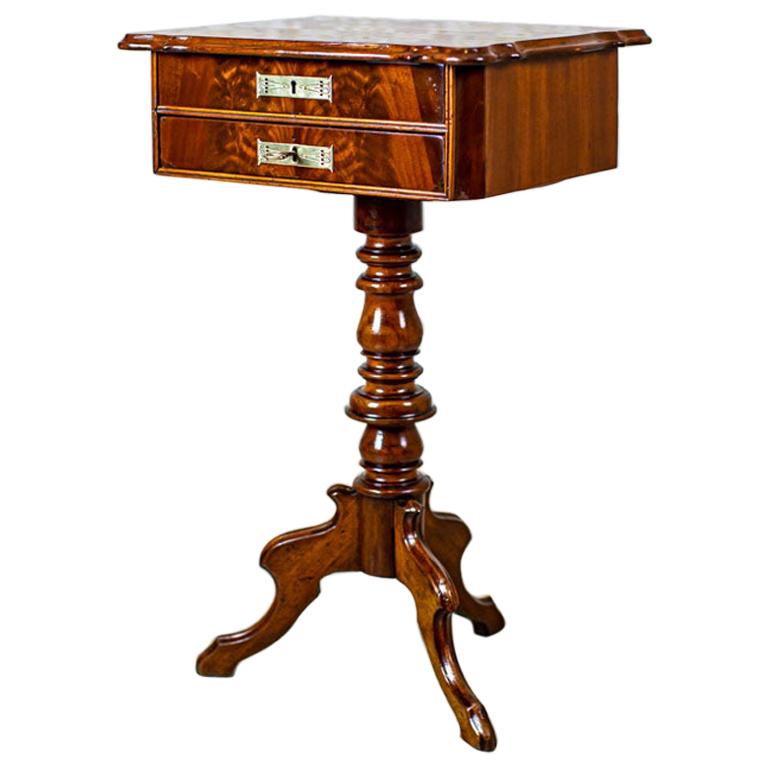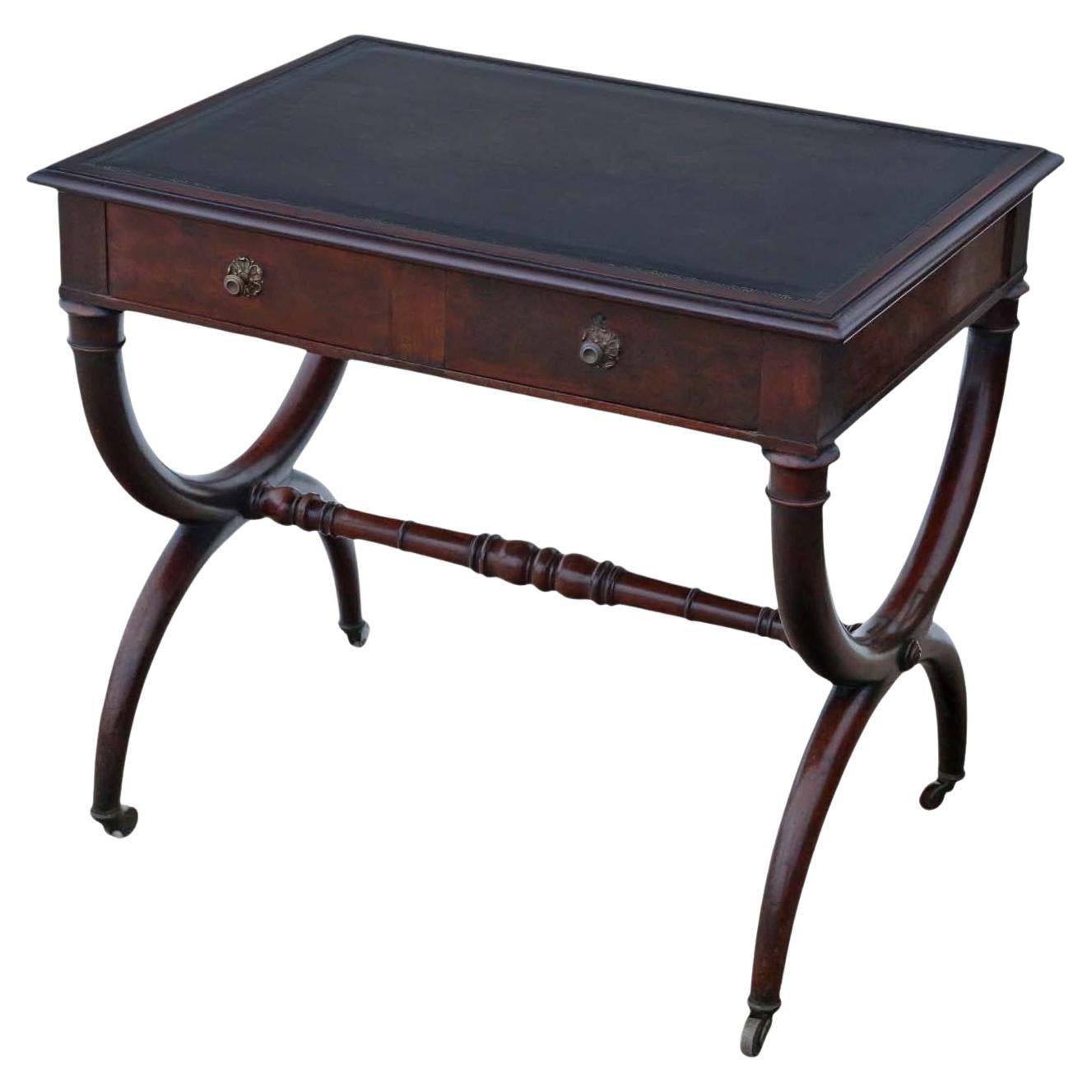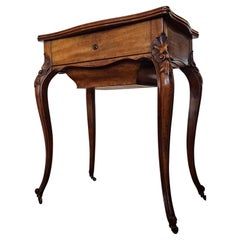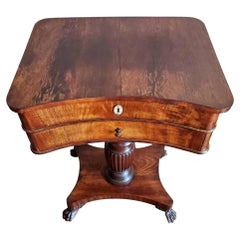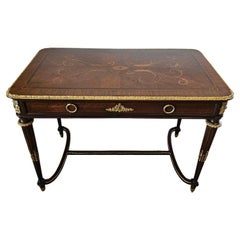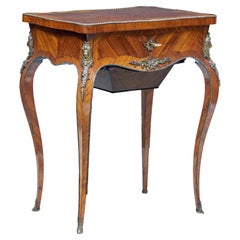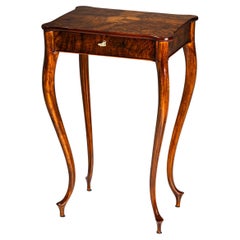Items Similar to 19th C. French Charles X Restoration Period Sewing Stand Work Table
Want more images or videos?
Request additional images or videos from the seller
1 of 9
19th C. French Charles X Restoration Period Sewing Stand Work Table
$1,960
£1,488.67
€1,712.24
CA$2,738.50
A$3,053.74
CHF 1,593.31
MX$37,470.57
NOK 20,280.33
SEK 19,215.17
DKK 12,779.09
Shipping
Retrieving quote...The 1stDibs Promise:
Authenticity Guarantee,
Money-Back Guarantee,
24-Hour Cancellation
About the Item
A scarce period Charles X (1818-1834) French Restoration mahogany travailleuse sewing (thread stand - side table - jewelry dressing table) with light, warm, beautifully aged patina.
Born in France in the early 19th century, almost certainly Parisian work, exquisitely hand-crafted, this exceptionally executed example features ornate gilt bronze ormolu mounts, escutcheons, and elaborate gilt metal trim. Having a highly figured light mahogany hinged lid top, lifting open to reveal a striking finished interior with divided compartments and original inset mirror plate. The conforming rectangular case fitted with a faux drawer front over a dovetailed drawer with sectioned interior. Elegantly rising on oval-shaped medial shelf stretcher-joined curvacious legs.
Dimensions (approx):
27" High, 20" Wide, 13.5" Deep
Stunning light almost blonde antique mahogany coloring and mellow warm tone, superb wood grain detail, and charming, beautifully aged patina over the whole. Great shape overall. Retaining original antique character marks, wear consistent with age and indicative of minimal use, nothing that detracts from the aesthetics or functionality, but only adds to the overall authenticity, refined elegant warmth, luxurious sophistication, and cozy unpretentious rustic elegance.
Delivered cleaned, hand waxed, polished French patina finish, ready for immediate use and generational enjoyment!
What is Charles X style:
The comte d’Artois – or Charles X - was the son of the dauphin Louis-Ferdinand de Franc and Marie-Josèphe de Saxe. He succeeded his two brothers Louis XVI and Louis XVIII and became the King of France in 1824. Thirty years after the French Revolution, he wanted to embody the return of monarchy and became the leader of the catholic party . As the previous kings, he was crowned in 1825 but he was soon overthrown by the revolution in July, 1830, called "Trois Glorieuses". He left then for England, Scotland, Prague and Istria where he died in 1836.
Charles X style lasted from 1818 to 1834 and happened during the Bourbon Restoration (French Restoration). This style did not replace totally the style of furniture from the French Empire but it was different from the formalism in the Napoleonic era, during which strictness and simplicity were inspired by Greco-Roman art. Indeed, artistic fields flourished. In terms of furniture, this renewal was suggested by the softening of shapes. Even though the simple aspect from the French Empire was still visible, shapes became curvier with volutes and arabesques. Another distinction is the loss of the massive aspect of furniture and the decrease of dimensions in order to decorate smaller appartments. Handling ability and comfort were key-words in the making of furniture. Apartments had essential elements such as chests of drawers, big rounded tables in the dining room, desks or secretaries, armoires and even dressing tables, comfortable fainting couches in the living room, small tables, pedestal tables, as well as gondola chairs. The wavy aspect of the latters certainly represent Charles X style the best.
One of the most emblematic features of this style is the use of bois clairs – light woods in warm blond tones - and indigenous woods that are varnished in order to highlight the grains. Bird's-eye maple, ash trees, plane trees, yew trees, beech trees, olive trees and cedar trees were most likely to be used. Indeed, at the beginning of the 19th century dark woods were hard to find. In 1806, the Napoleon’s Continental System was established in order to ruin the United Kingdom by preventing the country from any business with the rest of Europe. Therefore craftsmen had to find alternatives from mahogany which was the most commonly used material at this time. After 1815, the import of wood was even more difficult because of peace treaties and the European political situation, which contributed to the popularity of the bois clairs and indigenous woods. The furniture was often decorated with fine inlays made out of dark wood representing foliage, which contrasted with the veneer. Even though these patterns can look like bronze decorations from the Empire era, they were far more simple and did not represent any military or mythological attributes. On the tables, trays were sometimes made out of marble as in the French Empire, but it was often put aside and inlaid veneer, Verre Eglomisé – a type of glass with a mirror finish –, mirror or porcelain from Sèvres or Paris were more likely to be used.
Decorative elements from the Monarchy were highly appreciated again as they suggested luxury. Indeed, marquetry work was particularly fashionable - Boulle marquetry thrived around 1820 as the works of the Levasseur family can show. In the same way, draperies and trimmings referred to the monarchist splendour. Fabrics were often white – the traditional colour of the Bourbons – or light coloured as oppposed to the typical green from the Napoleonic era.
One of the most symbolic figures from this period of time might be Jean-Jacques Werner (1791-1849), a cabinetmaker who worked for prestigious clients such as the Duchesse de Berry who was Charles’s step-daughter. His works can be seen at the Musée des Arts Décoratifs and at the Grand Trianon in the Palace of Versailles. The duchess’s appartments situated at the pavillon de Marsan and at the Palais de Saint Cloud illustrate Charles X style the best with furniture made out of bois clairs and ornamented with dark wood patterns or fine gold decorations.
Chales X style allows a transition between the sobriety of the Empire style and the abundant aspect of Louis-Philippe style. The gothic style started at this time through the "style à la cathédrale", inspired by religious architecture, which thrived from 1827 to 1830. Indeed, at the beginning of the 19th century, Romanticism put the spotlight on the Middle Ages. Cabinetmakers were not inspired by the medieval furniture but rather by architectural elements of churches and cathedrals. For instance the backs of chairs were decorated with arches shaped like rib and serration. In the same way, before Charles X abdicated, pieces of furniture were made out of dark woods – such as mahogany, which was used again in France – and were inlaid with light wood. Romanticism also influenced the layout of furniture in appartments to suggest movement through a mix of various styles, various shapes and various sizes, as opposed to the static aspect of Neoclassicism. The start of industrialisation and mechanisation also influenced this style as early technical developments led to the production of pieces of furniture in series.
Credit:
Marc Maison
Bibliography:
FANIEL Stéphane (Dir.), Le Dix-neuvième Siècle Français, Collection Connaissance des Arts, 1957, Hachette
SASSONE, Adriana Boidi, Furniture from Rococo to Art Deco, 2000, Evergreen
--
Extremely versatile:
As warm and attractive as it is useful, this remarkable antique table having the ideal size and small proportions for a variety of different uses, including as a side table, accent or occasional table, tall sofa end table, bedside nightstand, petite hall console or entry table, ladies vanity, dressing table or gentleman's valet, decorative arts, plant or lamp stand and more!
Shipping/Delivery available
Pickup available near Dallas, TX.
- Dimensions:Height: 27 in (68.58 cm)Width: 20 in (50.8 cm)Depth: 13.5 in (34.29 cm)
- Style:Charles X (Of the Period)
- Materials and Techniques:Bronze,Mahogany,Mirror,Ormolu,Ebonized,Gilt,Inlay,Veneer
- Place of Origin:France
- Period:Early 19th Century
- Date of Manufacture:circa 1820
- Condition:Wear consistent with age and use. Minor losses. Minor fading. Great original antique condition. Retaining antique character marks, wear consistent with age and indicative of use, minor losses, light fading, heavily distressed mirror with age spots. Delivered cleaned, waxed, polished, ready for immediate use.
- Seller Location:Forney, TX
- Reference Number:1stDibs: LU5977226965562
About the Seller
4.8
Platinum Seller
Premium sellers with a 4.7+ rating and 24-hour response times
Established in 2013
1stDibs seller since 2021
290 sales on 1stDibs
Typical response time: <1 hour
- ShippingRetrieving quote...Shipping from: Forney, TX
- Return Policy
Authenticity Guarantee
In the unlikely event there’s an issue with an item’s authenticity, contact us within 1 year for a full refund. DetailsMoney-Back Guarantee
If your item is not as described, is damaged in transit, or does not arrive, contact us within 7 days for a full refund. Details24-Hour Cancellation
You have a 24-hour grace period in which to reconsider your purchase, with no questions asked.Vetted Professional Sellers
Our world-class sellers must adhere to strict standards for service and quality, maintaining the integrity of our listings.Price-Match Guarantee
If you find that a seller listed the same item for a lower price elsewhere, we’ll match it.Trusted Global Delivery
Our best-in-class carrier network provides specialized shipping options worldwide, including custom delivery.More From This Seller
View AllAntique French Ledet et fils Louis XV Ladies Sewing Work Table Dressing Vanity
Located in Forney, TX
Refined country French elegance and sophistication at its finest, this Provincial Louis XV style lady's sewing stand work table or coiffeuse by Ledet et fils exudes refined grace and functionality.
Born in Bordeaux Region of Southwestern France in the mid-19th century, exceptionally executed in sophisticated King Louis Fifteenth (1715-1774) taste, hand-crafted of warm mellow solid mahogany, having a rectangular serpentine shaped hinged top opening to reveal the original flat mirror plate, over a removable divided tray, faux drawer front with wooden escutcheon, above a sewing / work bin, gently curved scalloped apron, all rising elegantly on long cabriole legs adorned with finely carved shell acanthus leaf knee ending in whorl feet, terminating on casters. circa 1850s
Signed, retaining the original ébéniste (cabinetmakers) makers mark to the underside, reading:
Ledet
Fab de Meubles
Bordeaux
Dimensions: (approx)
29.25" High, 24" Wide, 16.75" Deep
Versatile:
As warm and attractive as it is useful, having the ideal size and proportions for a variety of different uses, including as a side table, accent table, hall console, sofa table, bedside nightstand, rolling lamp...
Category
Antique Mid-19th Century French Louis XV Side Tables
Materials
Wood, Mahogany
Early 19th Century American Classical Sewing Stand
Located in Forney, TX
A fine and rare, beautifully restored American Classical period sewing stand work table in mahogany and rosewood.
Elegantly sophisticated, this scarce antique is a wonderful example of high quality early 19th century American craftsmanship. Exhibiting fine detail throughout, the exquisitely handcrafted work table features a hinged shaped top with rounded corners, curved concave front, stunning highly figured matched rosewood inlay complimented by mahogany cross banded edge, set over a conforming shaped case. Lifting the top opens to reveal a fitted interior divided into eight compartments, including a hinged lid with built-in flip-up pin cushion, various size shaped lids are finished in mahogany accented by contrasting satinwood string banded border, a faux drawer front with contrasting mother-of-pearl escutcheon rests above a single frieze drawer with hand carved dovetail joinery and original turned wooden pull. Below, a perfectly proportioned carved, turned and fluted solid mahogany central pedestal rises from a shaped platform base, in true Empire fashion, the base is further raised on ornately carved paw feet.
Beautiful, rich antique mahogany color...
Category
Antique Early 19th Century American Classical Industrial and Work Tables
Materials
Mother-of-Pearl, Mahogany, Rosewood, Satinwood
Maison Forest Signed French Louis XVI Style Writing Table - Late 19th Century
By Maison Forest
Located in Forney, TX
A rare and very fine quality 19th century French bureau plat by renowned Parisian ébéniste Maison Forest.
Maison Forest is one of the most famous french cabinetmakers of the 19th a...
Category
Antique Late 19th Century French Louis XVI Desks and Writing Tables
Materials
Bronze, Ormolu
Early 19th Century English Regency Period Sewing Table
Located in Forney, TX
An elegant Regency period English mahogany and rosewood work table, circa 1815, in the manner of Gillows, having an attractive flame mahogany top with rope trim detail, above a singl...
Category
Antique Early 19th Century Regency Side Tables
Materials
Fabric, Mahogany, Rosewood
Early American Classical Empire Period Flame Mahogany Sewing Stand Work Table
Located in Forney, TX
A rare fine quality Federal period American Empire flame mahogany sewing stand work table from the early 19th century.
Exquisitely hand-crafted in the northeastern United States, most likely Philadelphia, Pennsylvania, circa 1820, having a hinged top, opening to reveal contrasting Birdseye maple marquetry oval cartouche inlay, a fitted maple divided compartment interior, the front having two nicely shaped curved drawer fronts, consisting of a faux drawer front over a single dovetailed ogee drawer, above a vasiform pedestal standard, molded stepped platform base, rising on bracket feet, resting on casters.
Attractive highly figured crotch cut swirl mahogany with striking grain patterns, rich and deep antique wood color...
Category
Antique Early 19th Century American Empire Side Tables
Materials
Birdseye Maple, Mahogany
Period French Napoleon III Mahogany Bonheur Du Jour Antique Ladies Writing Desk
Located in Forney, TX
A charming Napoleon III Second Empire Period (1852-1870) mahogany Bonheur Du Jour de dame(ladies writing desk) circa 1860
Hand-crafted in France the third quarter of the 19th centur...
Category
Antique Mid-19th Century French Napoleon III Desks and Writing Tables
Materials
Leather, Mahogany
You May Also Like
19th Century French kingwood sewing work table
Located in Debenham, Suffolk
Good quality french 19th century work table circa 1870.
Shaped top surface with chequered pattern in kingwood and tuilpwood, with ormolu edging. Further mounts to the drawer fronts...
Category
Antique Late 19th Century French Victorian Side Tables
Materials
Ormolu
Antique Maison Alphonse Giroux Paris French Louis XV Vanity Table Sewing Stand
Located in Philadelphia, PA
Antique Maison Alphonse Giroux Paris French Louis XV Style Vanity Table Sewing Stand. Item features a shaped glass top, signed "Alph. Giroux S Cie Paris" by Maison Alphonse Giroux, b...
Category
Antique Late 19th Century Unknown Louis XV Vanities
Materials
Bronze
Sewing Table, Late 19th Century
Located in Greding, DE
Delicate sewing table standing on slender, elegantly curved legs, crafted from finely polished walnut with beautiful veneer grain. The shaped top opens to reveal a meticulously organ...
Category
Antique Late 19th Century German Louis Philippe Side Tables
Materials
Walnut
19th-Century Louis Philippe Sewing Table with Inlaid Top
Located in Opole, PL
19th-Century Louis Philippe Sewing Table with Inlaid Top
We present you a sewing table, circa 1860, in the Louis Philippe style.
The rectangular apron hides two drawers.
It is toppe...
Category
Antique 1860s European Louis Philippe Side Tables
Materials
Wood
Antique Fine Quality Mahogany Writing Dressing Table 19th Century Desk Side X-Fr
Located in Wisbech, Cambridgeshire
Antique Fine Quality Mahogany Writing Dressing Table, 19th Century – also ideal as a desk or side table. A highly desirable piece featuring a sought-after X-frame stretcher base.
Th...
Category
Antique 19th Century Desks and Writing Tables
Materials
Wood
$2,392 Sale Price
30% Off
Baroque Sewing Table, sig. Benz, 18th Century
Located in Greding, DE
Small Baroque sewing table, signed Benz, featuring a sliding top and an interior compartment layout. The surface is walnut-veneered and adorned on all sides with exquisite floral mar...
Category
Antique 18th Century Baroque Industrial and Work Tables
Materials
Walnut
More Ways To Browse
High End Antique Furniture
Antique Jewelry Table
Ladies Work Table
Arabesque Table
Gold Plant Stands
Round Table French Polish
Art Deco Plant Stand
Small Table With Shelf And Drawer
Antique Jewelry Restoration
Metal Inlay On Table Top
Plant Stand Round
Couch Tray Table
Art Deco Plant Table
Bird Marble Table
Ornate Round Table
19th Century Sewing Table
French Round Metal Dining Table
Metal Dressing Table

